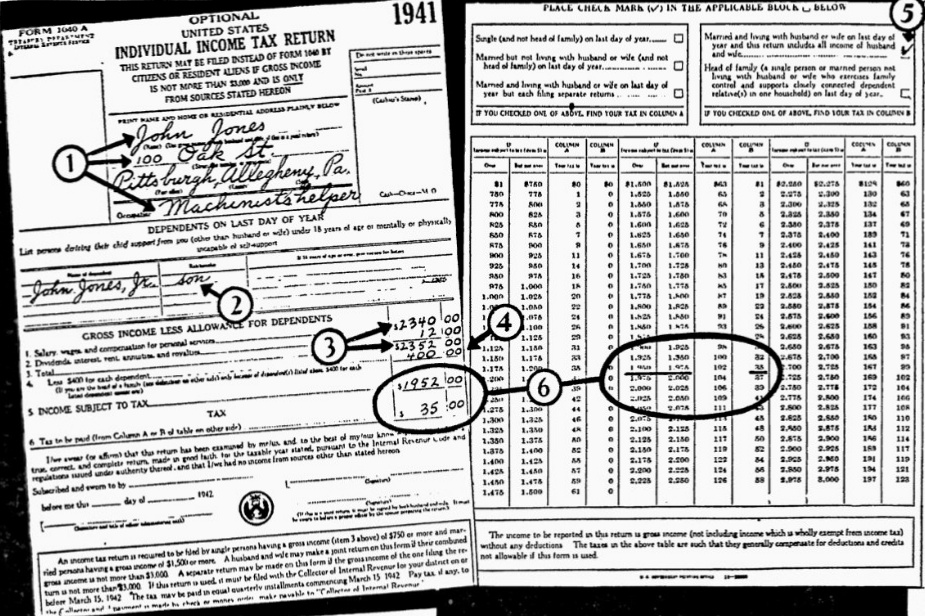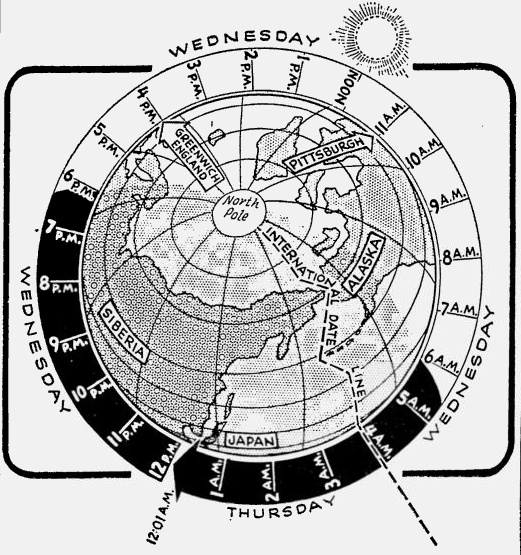The Pittsburgh Press (January 11, 1942)
To raise money for war –
U.S. taxpayer may pay two levies in 1942
Wage deduction planned in addition to regular income assessment
‘Jiffy’ tax blank figures all for those with small incomes

This is the “jiffy” income tax return for thousands of small taxpayers ($3,000 or less income) who are being confronted with income tax blanks for the first time in their lives. Simple as ABC, Form 1040A can be filled out in six quick, easy steps – compared with a minimum of 21 entries on the standard Form 1040. As shown above:
1. Write in your name, address and occupation.
2. Enter your dependents, except husband or wife.
3. List your income for 1941.
4. Subtract your credit for dependents.
5. Check your family status.
6. Read your tax directly from this table on the back of the form. In the case illustrated, the tax is found in Column B – for married men and heads of families.
Washington (UP) – (Jan. 10)
Adoption of the proposed salary withholding tax as part of the new $9 billion war revenue program would mean that Americans would have to pay two tax bills at once during the last half of 1942.
The withholding tax would probably go into effect July 1, the beginning of the 1943 fiscal year. In addition to paying this tax on current earnings, Americans would still have to pay the final two installments of the tax on 1941 income.
Taxes on incomes for both 1941 and 1942 exceed by far any previous ones. Pyramiding them would have the effect of more than doubling income taxes for the final six months of this year.
Strain considered
The Treasury has not decided upon the exact form of the withholding, or “at-the-source tax,” it will recommend, and is taking into consideration the terrific strain that any double payment of taxes will have on family budgets.
Randolph Paul, a New York attorney who was drafted to work out the Treasury’s tax program, said:
It is tough to have to pay two years of taxes in one year and we are trying to get out of it as much as possible.
He added that “no particular hostility” to a withholding tax had developed in conferences of Treasury officials and Congressmen.
Studies proposal
The Treasury is studying several proposals for a withholding tax. One provides that income taxes be increased 5-15%, with the increase only being collected at the source. Under another proposal, income taxes would be increased an undetermined amount and the entire tax would be collected at the source.
The most talked-of withholding tax rate at this time – though not necessarily the one that will be adopted – is 15% of net taxable income, which would be superimposed on the normal income tax. Here is how it would work if you are a married man, with no children.
Your employer would estimate your yearly earnings for this year deduct $1,500 for personal exemption and perhaps 10% of your entire earnings for taxes paid, contributions, etc. The remainder would be your net taxable income from which he would take out 15% in equal installments each payday, sending the amount to the government. This would be collected in addition to your regular income tax.
But the following year, 1943, when it came time to compute your regular income tax in the regular way, you would deduct from your total income the amount of the withholding tax paid out in 1942. That amount is tax-free.
Would lower exemptions
One proposal under consideration would lower personal income-tax exemptions to $500 for single persons and $1,000 for married men without children.
With his lowered exemption, the addition of a 15% withholding tax would cost a married man without children, earning $2,000 annually, approximately $135 a year, or $2.59 a week. The regular income tax, computed at present rates, would be about $73.
The administration is also considering raising the employee’s Social Security tax from 1% to 3% – which would be $60 a year on the $2,000 income.
The wage-earner getting $2,000 a year, or $38.50 a week, thus would pay a total direct federal tax of $268 a year, or $5.15 a week – more than 13% of his gross income.
The most pressing taxation problem before Americans is not the question of future taxes, however. The first quarterly installment of income taxes on last year’s earnings is due March 15.
This will be the first income tax paid under the 1941 act, passed last September, which sharply increased rates and lowered exemptions to include many additional thousands of wage-earners.
Must file return
All single persons having gross incomes of $750 and all married persons with gross incomes of $1,500 must file returns.
The Treasury estimated 22 million returns will be filed.
The normal income tax rate on individuals remains at 4%. The surtax rate has been increased to a graduated scale from 6% on the first $2,000 of income after exemptions, to 77% on incomes exceeding $5 million.
Indicating how much the income taxes have been hiked, the married man without children (earning $2,000 a year), will be taxed $117, nearly three times the amount he paid last year.
Task made easier
Only in one particular has the task of paying the tax on 1941 income been made easier. The Treasury has simplified computing of the tax.
Persons earning less than $3,000 may fill out a single form and pay a tax calculated by the Treasury on the basis of average deductions for gifts to charity, interest paid and similar items.
The form for other taxpayers has also been simplified. Persons whose income is entirely from salaries and other compensation for personal services, dividends, interest, rents, royalties have to fill in only two pages.
Tax plans cause friction in capital
Washington (UP) – (Jan. 10)
The huge war financing program, which is expected to take more than one-fourth of the 1942 national income, was complicated tonight by increasing friction between the administration and Congressional tax committees.
Influential members of the House Ways and Means and Senate Finance Committees nurse a grudge against the administration because of last year’s fight over mandatory joint return and excess profits issues, were angered by the Treasury’s reported attitude on a general federal sales tax and the excess profits levy.
Members of the Ways and Means Committee were taking these views tonight:
-
The Treasury is trying to maneuver Congress into enacting a general sales tax without its being labeled an administration measure – which would permit the administration to tell labor and low-income groups that it had nothing to do with the tax.
-
The Treasury is attempting to force Congress to accept an excess profits proposal that was rejected last year.
Unless immediate steps are taken to establish harmony, some Congressional leaders fear, the projected $9 billion revenue bill will be a more complex hodgepodge than any previous tax legislation.
Chairman Robert L. Doughton (D-NC) of the Ways and Means Committee and Chairman Walter F. George (D-GA) of the Senate Finance Committee were reported to have flatly informed Secretary of the Treasury Henry Morgenthau Jr. at a preliminary conference that they would not consider extension of Social Security taxes as part of the regular revenue bill.
Treasury officials and bipartisan fiscal leaders of Congress are to meet again Monday in an attempt to reach agreement on a war tax program before it is made public by the House Ways and Means Committee.





